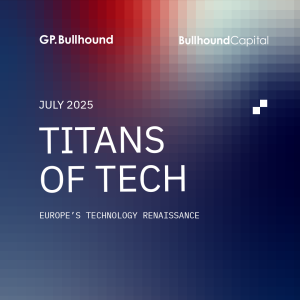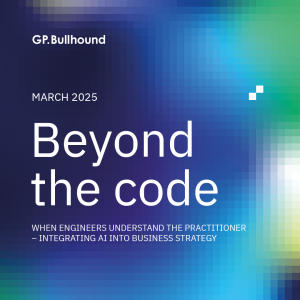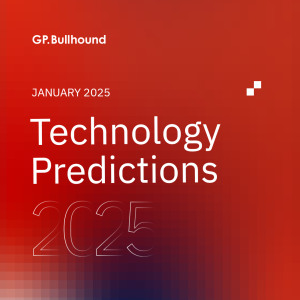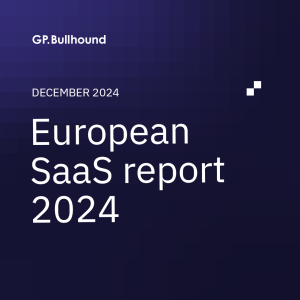Tech Thoughts Newsletter – 15 September 2023.
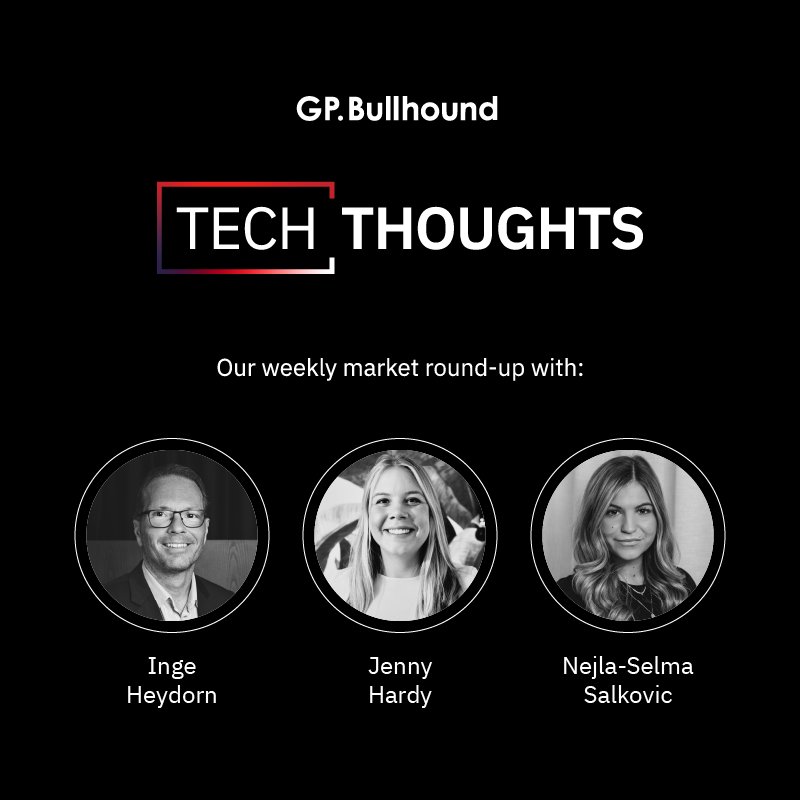
Market: Another week, more inflation data, more volatility. ARM’s +25% pop on day one should be helpful for the reopening of the IPO market (we give our views on the company below).
Portfolio: We made no major changes to the portfolio this week
ARM – a reopening of the IPO market but with question marks on the business and valuation
- ARM came back to the public markets this week, this time around listing on the Nasdaq.
- We chose not to participate in the IPO, and prefer to watch (at least for some time) from the sidelines, but a bit of a compare and contrast vs. 2016 (when it was last listed) is helpful.
- At $64 where ARM closed on Thursday, puts the valuation at 25x 2023 (March y/e) revenue. In June 2016, ARM was taken out (ie. post the 20% premium paid) at $32bn, about 21x revenue.
- But Softbank/Masa have spent the last seven years “investing for growth” at ARM, and operating margins have gone from over 40% in 2016 to 25% in 2023, which means the P/E multiple is 130x today (vs 57x at the 2016 take-out) and indeed among the highest valued stocks we look at.
- It’s a lot for a business that makes most of its money from a market that isn’t growing anymore (in 2016, you still had a decent penetration/premiumisation story). ARM’s revenue actually shrunk last year.
- The areas of semis we prefer exposure to – AI and autos – remain fairly nascent for ARM; and while there is a bull case (ARM’s lower power architecture could be hugely relevant in the server/AI space – remember Nvidia tried to buy ARM) there are a lot of uncertainties and a leap of faith is definitely required to believe they will get to the same ubiquity in these new markets as they have in smartphone.
- Not to mention quite a lot of risk factors: China, RISC-V competition, and the ongoing legal war with Qualcomm.
Portfolio view: For now, we watch from the sidelines. As well as the points outlined above, there is a further difficulty in ARM’s business model in that its royalties relate to chip price, not end device price. That’s why it so under-earns its real value at Apple (ie. it doesn’t really benefit from Apple’s $1,000 pricing, even though every single iPhone is built on ARM).
Over time, ARM should benefit from chip design becoming more complex, in that more OEMs (like Google for its in-house AI chips) want their own customised chips (just like Apple did). The problem is that Apple can effectively choose its own price for its own developed A17 chip, and this is the price that ARM charges a percentage of. It might always make it hard for ARM to capture its true value.
Apple iPhone launch
- Another year and another dull iPhone launch.
- Pretty much everything that was announced at the event on Tuesday was already rumoured: there is a new 3nm (TSMC) A17 Pro chip, which means a slightly better battery life. It’s a bit boring, but that’s what Apple is now: a cash-rich consumer staple company.
- On the chip side, the A17 Pro implies there might be a A17 “non-pro” – which will probably be used in the lower-end iPhone models next year (likely with lower GPU specs). We also assume this will form the basis for the next Mac M3 chip.
- Much was made of Apple pushing up pricing – it’s worth noting that the price increase of the Pro was probably less than most had expected, and only a higher memory version of the iPhone Pro is being released (256GB vs a 128GB model for the 14, which makes price comparisons unfair).
- Inflation-adjusted, iPhones haven’t become much more expensive in recent years. But, by rights, technology and Moore’s law are deflationary, and Apple continues to maximise gross margin by continuing to squeeze its component suppliers.
- Keeping prices relatively flat – in real terms at least – does fit in with Apple’s services strategy – maximising the installed base and monetising them elsewhere.
Portfolio view: We own Apple, and broadly, we view it as a relatively defensive, high ROIC consumer tech business, continuing to grow share, and a reasonably visible (given built-in battery obsolescence) replacement cycle.
AI driving ARPU upside for enterprise software businesses
- Adobe (owned) reported a good beat at results (~13% ahead of consensus) and good guidance, but more interesting was its new pricing announcements. It announced a series of Gen AI updates and the standalone pricing of Firefly, its generative AI application. Firefly will be included in the broader creative suite alongside a 6-10% price increase across its Creative Cloud plans. It will also be priced at $4.99 a month as a standalone freemium model (consumer-type pricing to drive mass market adoption).
- Salesforce (owned) held its annual Dreamforce event in San Francisco and, unsurprisingly, talked a lot about AI. The biggest announcement was the Einstein 1 AI platform, which sits on top of its own Einstein GPT. Pricing for Salesforce products was raised earlier this year, and though we still don’t have hard standalone pricing for Salesforce’s AI products, it is clearly helping them justify broader price increases.
- Given Salesforce’s product set around data cloud, marketing and commerce clouds and Slack – they are well set up to utilise AI. In just the same way as Microsoft operating AI across its suite of apps is compelling, Salesforce should be able to do the same – the AI starter pack includes features around Slack, Tableau, Einstein, Mulesoft and Data Cloud.
- Its AI features will allow its users to do things like auto-generate code for developers, generate marketing landing pages for marketers and write customised sales emails.
- We’ve spoken before that AI as an enterprise opportunity makes sense. Established enterprise software businesses that are able to (1) leverage very large installed bases to upsell AI features; (2) have large cash balances to invest in AI; (3) have the right business model for AI to match the increased cost, ie. subscription.
- For enterprise software customers, it makes much more sense to get AI capabilities via their existing platform software providers (Microsoft, Workday, ServiceNow, Salesforce, Adobe can also benefit from upselling AI features) than to try to implement it themselves.
- One helpful piece of data that was given was around the ROI that customers have seen having implemented Einstein. In sales teams, they say they have seen 29% increase in productivity – again, when AI implementation can be about genuine direct cost savings for businesses and a tangible ROI is clear, there are reasons to be positive about the sustainability of AI demand.
Portfolio view: The question for us in software and AI has been when and if AI starts to be a meaningful revenue generator for software companies, rather than the current cost of doing business. Salesforce and Adobe’s monetisation plan is helpful in that it starts to answer that question. We ultimately think AI will lead to more consolidation of spend in the space, and those “platform-like” software businesses (we own Microsoft, ServiceNow, Salesforce, Workday and Adobe) are the best positioned both from a scale of investment and from a product set perspective (with an ability to leverage AI tools across a broad product suite).
We would note that nothing’s for free – all of these businesses will likely need to either increase capex to build out their own infrastructure or buy AI compute capacity from cloud providers, which will likely impact their gross margin. In the context of their existing businesses, AI is still small, so we’re not seeing that yet, but it’s something to watch, and key for us in the portfolio are those businesses that can generate a meaningful and sustainable return on invested capital from those AI investments.
The AI arms race continues
- Oracle (not owned) reported an okay set of results, but the standout was cloud revenue (they are the fourth public cloud provider behind AWS, Azure and Google), which was up 64% yr/yr (currently growing fastest, albeit at much smaller absolute levels) with the outlook showing continued cloud strength (Oracle is in catch-up mode and gaining, albeit from much lower share levels).
- Oracle is one of the few vendors with compute scale and GPU capacity and so is seen as a beneficiary of AI. Management called out that AI companies have signed $4bn worth of capacity in cloud, double the amount signed at the end of Q4.
- Oracle announced later in the week that its database management solutions will also be available on Microsoft’s Azure. It’s a big change in Oracle’s cloud go-to-market and means Oracle customers can now migrate their database to cloud via Microsoft Azure, instead of relying on Oracle’s own in-house cloud solution. It speaks to Microsoft’s increasing ubiquity in cloud (it is still second after Amazon’s AWS but gaining share in part thanks to its OpenAI association).
Portfolio view: Like all the hyperscalers, Oracle needs to invest in AI to keep up with competitors doing the same. We don’t own Oracle but, importantly for us, their 12-month trailing capex spend almost doubled yr/yr and is expected to stay at similarly high levels. It’s important for our thesis on Nvidia, AMD and TSMC – cloud players need to spend on GPU compute capacity and AI features to maintain share – that ultimately means more high-end servers and more chips.
EV – price war and subsidies, good for chips, bad for auto OEMs
- We’ve written a lot about the price war in electric vehicles, driven largely by China and, indeed, the very strong China EV exports this year (one of the few bright spots in Chinese economic data).
- This week, the European Union launched an investigation into Chinese subsidies for electric vehicles, which they argue (probably correctly) is distorting pricing in the market.
- The comparison being made is with the European solar industry, where state-backed Chinese competition killed the industry. It’s another leg in the reversal of globalisation we’re seeing across industries (most notably for us in the semiconductor industry).
- We think the barriers to entry and pricing power in an EV world are even lower than the traditional combustion engine market, which has historically been a difficult industry in which to make a sustainably high return – we expect to continue to see price wars, regardless of the conclusions of the European investigation. The reality is that European EV production targets are also a recipe for a race to the bottom in terms of pricing.
Portfolio view: We continue to hold Infineon and NXP where we see their autos businesses remaining largely sold out into 2023 – they benefit from the increased semiconductor content in EV vs ICE and, unlike auto manufacturers, have high pricing power and high return on invested capital. We don’t invest in any Electric Vehicle/auto manufacturers.
Monthly numbers from Taiwan – stability, though still uncertain end demand
- TSMC’s August revenue was +6% mth/mth from July, the second month of sequential growth, which we believe is benefitting from Nvidia GPU demand filling in 7nm (A100) and 5nm (H100) demand, as well as Apple’s 3nm A17 chip demand.
- UMC stable again – hovering at NT$19bn, relatively stable month on month though still tracking 25% below year-ago levels. That speaks to the weaker PC and smartphone market.
- August Notebook shipments (Quanta, Compal, Wistron, Pegatron and Inventec) were up slightly (+2%) yr/yr – slightly better than expected, with back-to-school demand, new product launches, and inventory build all helping. Still, end demand isn’t obviously returning, and the expectation is for the rest of the year to remain fairly subdued (albeit stabilising and not getting worse). Still, this is a market we do our best to avoid.
Portfolio view: Stabilisation is good news, particularly amidst the very weak smartphone end demand. We still think TSMC 5nm capacity will be filled by Nvidia H100 demand, as Apple shifts from 5nm to 3nm for its A17 chip.

For enquiries, please contact:
Inge Heydorn, Partner, at inge.heydorn@gpbullhound.com
Jenny Hardy, Portfolio Manager, at jenny.hardy@gpbullhound.com
Nejla-Selma Salkovic, Analyst, at nejla-selma.salkovic@gpbullhound.com
About GP Bullhound
GP Bullhound is a leading technology advisory and investment firm, providing transaction advice and capital to the world’s best entrepreneurs and founders. Founded in 1999 in London and Menlo Park, the firm today has 14 offices spanning Europe, the US and Asia.
